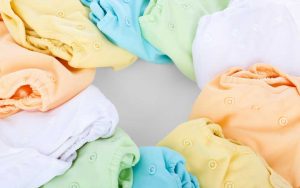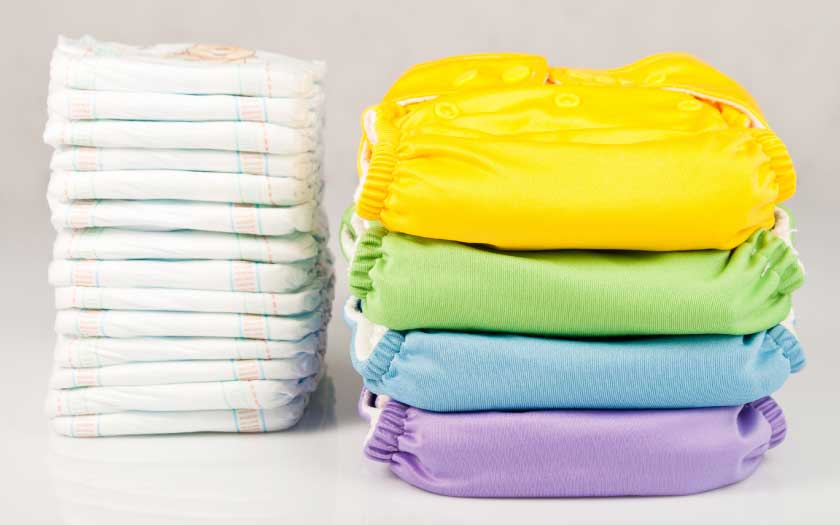Diapering one’s child has never been such a topic of debate as it is today, mainly between parents who use cloth diapers and disposable diapers. While we do believe that to each his own, there is still a lot to debate on.
From the topic of convenience to hygiene and responsibility towards the environment, we can’t possibly deny that the choice of which kind of diaper to use on one’s baby does garner some interesting thoughts and conclusions.
What are your choices based on?
For some parents, their choice of diapers is based on their consciousness as well as concern about the ill-effects of non-biodegradable material filling up the countless landfills on earth. For others, it may just be a matter of which diaper is more convenient to use and dispose of, while still others may make their choice based on the brands they happen to like. How do you make your choice of diapers for your little one?

Modern diapering could mean anything from simple cloth diapering to super-absorbent disposable diapers. The whole term ‘modern diapering’ itself can be a tad confusing to explain, because, for many, it refers to cloth diapering, which in a way is turning back the clock to how diapering was done many, many decades ago, using reusable diapers. On the other hand, we have parents who liken the term ‘modern’ to convenience above all, and nothing beats the convenience of disposable diapers, no matter where you go in the world.
So, let’s dissect this issue right now and go into the nitty-gritty of both cloth diapers as well as disposable diapers, before leaving the choice to you.
Cloth diapers
Are you new to the concept of cloth diapering? Or perhaps you’re considering using them for your baby? Well here’s what you can expect in terms of benefits.
Cloth diapering will save you money.
The cost of disposable diapers is approximately RM8,300 from the time your baby is born until he is potty-trained. As for cloth diapers, you’ll only need about 24 one size fits all diapers, assuming you’ll be washing them regularly. At the cost of about RM50 per diaper, you’ll be spending all-in about RM1,200 for your child’s diapers. Keep in mind too, that you can reuse these for your next child!
The bonus point here is, you’ll probably buy your cloth diapers before your baby is born, which means that you could potentially be eliminating your future diapering expense even before your baby arrives!
It’s 2019: There are no folding or pins involved!
Contrary to what you may have in mind, modern cloth diapers are not the same as the ones many of us may have been diapered in when we were babies. They are, today, more efficiently designed and more user friendly than they have ever been. You also do not have to own the skills of an origami folding artists to use one either, for they’re way past folding, or pinning in place for that matter.
Prefolds, on the other hand, one of the cheapest options of cloth diapers, are rectangles of absorbent fabric with extra bulk in the middle and need to be fastened with a pin-less, diaper fastener, such as Snappi, then layered with a waterproof diaper cover.
Or, you may prefer pocket diapers, which resemble disposable diapers with easy fasteners – buttons or Velcro. These diapers have two-layers – a waterproof outer layer and a stay-dry inner layer, usually stitched from absorbent microfleece or suede cloth materials. The removable inserts can be washed and dried to be reused.
Parents have a choice of natural, eco-friendly materials like organic cotton, hemp, and bamboo. The extra special feature of cloth diapering is that the one-size reusable diapers grow with your baby from infant to potty-training age.
Reusable and money-saving in many ways
Depending on how well you take care of them, cloth diapers can be used from birth to potty training, and may even be passed on from sibling to sibling. If you have friends who are looking to save money and don’t mind buying second hand, you can sell them to recoup some of your initial investment.
The environmentally-friendly choice
While no one knows exactly how long it’ll take for a disposable diaper to completely break down inside our landfills, one thing’s for sure, every piece of it contributes to polluting the earth by adding poisons into the ground. The impact of that number can be truly felt when we consider that the United States Environmental Protection Agency (EPA) has reported that 20 billion disposable diapers, or 3.5 million tons of waste, are placed in their landfills every year. Note: That’ll be akin to 3.5 million great white sharks!

So cloth diapers save you money, they’re easy to use, they have environmental benefits, and the list goes on. Still, even cloth diapering is not without its own set of challenges.
You’ll need to wash them!
First, you’ll have to dispose of the poop, of course. So, yes, there’ll be a fair amount of poop-handling going on. Get used to that, and it’ll be just a matter of organising your nappy laundry to ensure you have fresh diapers all the time.
No throwing away soiled diapers when you’re out with baby
Instead, you’ll have to either find a way to dispose of the poopy content in a toilet or garbage bin, or you’ll have to bag the whole thing and see to it when you get home.
You’ll have to organise your laundry load well
Or else, you may run out of diapers, especially during times of baby diarrhea, etc. You also can’t afford to skip laundry too often, for this reason.
Disposable diapers
Disposable diapers were first introduced in the late 1950s and were extensively used from then on. For moms, it meant no more slogging away getting soiled nappies cleaned! Disposable diapers are made from an exceptionally absorbent core material that wicks away moisture from a baby’s skin, and most modern ones also feature a special top layer that keeps the baby’s skin dry. The outer layer is made waterproof so that urine and stools stay in the diaper.
Today, dozens of brands of disposable diapers are available in the market, allowing moms a multitude of choices. They even come in pull-up pant variants, also known as training diapers, that are even easier to use.
Convenience
We can’t talk enough of the convenience of disposable diapers for it does count when mothers choose disposable diapers over cloth ones. The main convenience it offers is that you can dispose of the whole diaper once it’s been soiled. This means that parents do not have to think about the added laundry load later on, as with the case of cloth diapers.
Quicker diaper changes
Less time is spent on changing them, which would become lesser as you get used to doing it. As a result, changing would become more practical for moms or dads, especially when they’re on the go.
Easily available.
Well, you can’t expect to walk into a 24-hour convenience store and buy a set of modern cloth diapers off the shelf, but you will indeed find several emergency packs of disposable baby diapers.
They have hypoallergenic variants
If your child happens to have a chemical or allergic reaction to the materials in standard diapers, you can choose diapers that are made to be hypoallergenic. It’s crucial though, as parents, to keep in mind that the term ‘hypoallergenic’ in diapers does not always carry a controlled definition and that some manufacturers would try to make claims that simply aren’t true.
The disadvantages
They ultimately cost more
Diapers are very expensive, especially when you consider that a baby can use up to 8 diapers in a day on average. Also, the prices of these products can vary according to their types and qualities, which can cause concern and confusion among parents. Ask any middle-income earning parent today and they might tell you that a pretty good portion of their budget is spent in buying disposable diapers each month – and for most of them, they run out of them before month’s end!
They’re likely to cause nappy rash
Nappy rashes tend to occur due to the reaction between a baby’s skin and certain materials used in the making of disposable diapers. For most parents, this has amounted to many visits to the doctor’s office or pharmacies, and also, changing diaper brands to find a suitable one that does not cause diaper rash.
They slow down toilet training in toddlers
Potty training takes up time and effort – the use of disposable diapers offer such convenience to parents that they often dilly dally when it comes to making an effort to potty train their child.
Little ones also seem quite comfortable in these diapers, a fact that does not help to push parents to hurry up and toilet train their kids.
The bottom line is, (pun intended!) the choice is ultimately yours to make, so choose well!
Sources:
https://www.thestar.com.my/lifestyle/family/features/2011/04/20/going-green-with-diapers
https://www.snappibaby.com/


